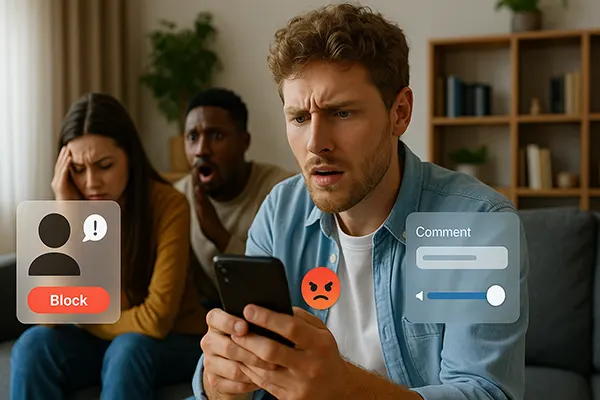
Prototoxic Content and Strategic Approaches to Strengthening Audience Mental Health
As social media continues to shape online discourse, the emergence of prototoxic content—subtly harmful posts that encourage hostility, manipulation, or polarisation—poses new risks to users’ mental well-being. Unlike overtly abusive content, prototoxic posts often remain undetected by traditional moderation tools, embedding themselves into everyday digital conversations. The real challenge lies in balancing open dialogue with safeguarding psychological health.
Understanding the Nature of Prototoxicity in Online Spaces
Prototoxic content refers to communication that isn’t explicitly harmful but promotes negative emotional states, group conflict, or subtle manipulations over time. This type of messaging may appear in sarcastic comments, mockery disguised as humour, or seemingly ‘harmless’ viral trends that reinforce exclusion or insecurity. Its insidious nature means it often bypasses detection while still inflicting emotional strain on users.
In 2025, platforms like X (formerly Twitter), Instagram, and TikTok continue to grapple with the complexity of moderating such content. The responsibility now falls not only on artificial intelligence but also on ethical design practices and user education. Emotional resilience becomes an essential part of digital literacy in today’s climate.
Prolonged exposure to prototoxicity can lead to desensitisation, anxiety, and emotional fatigue, especially among adolescents and young adults. To tackle this, a shift towards empathic content practices and proactive intervention is critical. Identifying triggers, encouraging nuance in conversations, and reducing antagonistic feedback loops are starting points for meaningful change.
Emotional Moderation as a Strategic Solution
One of the most effective approaches to reducing the influence of prototoxic content is emotional moderation—guiding discourse by anticipating emotional reactions. Moderators and automated systems alike are now being trained to identify emotionally loaded comment patterns and de-escalate them by prompting reflection or pausing interactions.
For example, several major social networks have introduced real-time prompts such as “Are you sure you want to post this?” to slow down emotionally reactive posts. These micro-interventions encourage users to reassess their tone and intent, reducing impulsive hostility and reshaping online culture from within.
Incorporating emotion detection tools also supports moderators by flagging emotional volatility. While AI can’t fully grasp human intent, it plays a supporting role in managing large volumes of interaction. Combined with human oversight, this creates a healthier environment for discussions to thrive without spiralling into conflict.
Soft Blocking and Algorithmic Throttling: Minimising Harm Without Silencing Users
“Soft blocking” strategies, such as content throttling or temporary comment delay, offer an alternative to outright bans or suspensions. By reducing the visibility or spread of emotionally provocative posts rather than deleting them, platforms can de-escalate situations without fuelling further resentment or censorship narratives.
Algorithmic throttling, already employed by Meta and YouTube, involves reducing the ranking or visibility of content that consistently triggers polarising or emotionally charged interactions. This doesn’t silence users—it simply places emphasis on moderation through distribution rather than restriction.
Delay features allow time for cooler heads to prevail. Users are less likely to post reactive or harmful messages when faced with a short wait period before their comment is published. This cooling-off period not only protects other users but can also lead to self-reflection and more constructive engagement.
Ethical Design and User Autonomy
Responsible design in 2025 increasingly includes tools that give users autonomy over their exposure to sensitive content. Customisable filters, pause functions for comment sections, and emotional feedback alerts are now integral parts of digital wellbeing interfaces.
These features don’t dictate behaviour—they inform and guide it. Users are empowered to make conscious choices about their participation in online discourse. Transparency in how content is prioritised and how moderation decisions are made further reinforces trust and accountability.
Integrating ethical design principles at the code level also means prioritising accessibility and mental health. Simple UI changes like colour-coded tone indicators or emotional sentiment bars can alert users when conversations trend toward aggression, giving them time to disengage or intervene constructively.

Community Education and Collective Responsibility
Beyond technical solutions, the cultural shift towards healthier online communication hinges on public awareness and education. Digital citizenship in 2025 includes understanding emotional contagion, disinformation patterns, and the psychological toll of constant engagement.
Schools and online platforms alike are now offering digital well-being modules focusing on emotional self-regulation, content discernment, and healthy commenting habits. These programmes aim to build long-term resilience by cultivating awareness of both external manipulation and internal reaction patterns.
Furthermore, communities thrive when they self-moderate through norms, not punishment. Encouraging bystander intervention, normalising empathy, and highlighting positive behaviour set the tone for meaningful engagement. Strengthening user agency is a shared effort, not just a technical fix.
Building Psychological Immunity in Digital Spaces
The idea of psychological immunity revolves around developing internal defences against subtle toxicity. Just as physical health requires regular maintenance, mental health needs boundaries, context awareness, and emotional clarity—especially in online environments.
Digital platforms and social apps in 2025 are beginning to integrate wellness check-ins, mindfulness prompts, and educational interludes to encourage users to pause and reflect. These micro-moments interrupt consumption loops and provide mental breathing space.
Ultimately, combating prototoxic content is not just about removing harmful posts—it’s about reshaping the digital ecosystem to value presence, compassion, and balance. This transformation requires cooperation between designers, users, and educators working together toward emotionally intelligent interaction.
